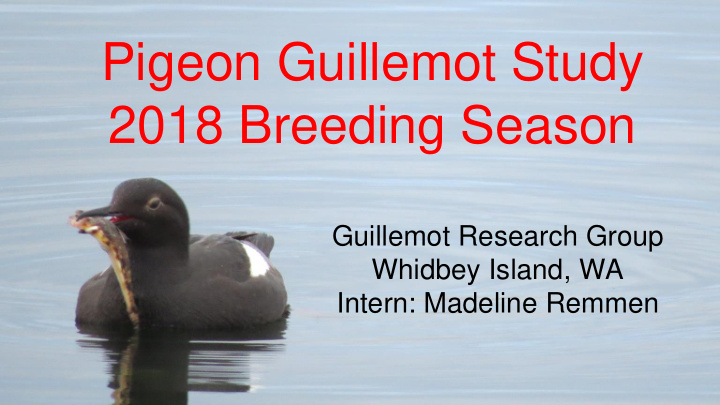



Pigeon Guillemot Study 2018 Breeding Season Guillemot Research Group Whidbey Island, WA Intern: Madeline Remmen
Pigeon Guillemots ● Cepphus Columba ● Alcidae family ○ Puffins, Auklets, Murres, Murrelets ● Native to the Pacific NW ● Remain in Puget Sound area year round ● Feed on fish and other invertebrates ● Nest in burrows
Project Focus ● Track type of prey delivered ● Track population ● Record all disturbances ● Continue to add data to baseline and monitor it
Colonies Studied ● 27 colonies across Whidbey Island ○ Monitored once a week for one hour by volunteers ● Intern focus colonies: Rolling Hills and Mutiny Sands
Methods ● Monday- Friday/ Tuesday- Saturday ● 6am-10am ● Track: ○ Population ○ Prey Deliveries ■ Gunnels ■ Sculpins ■ Other/ Unknown ○ Disturbances
Site Summary Rolling Hills ● Highest pop. count 45 ● Average pop. count 23 ● # of occupied burrows 6 ● 83% probable fledging success
Site Summary Mutiny Sands ● Highest pop. count 63 ● Average pop. count 22 ● # of occupied burrows 8 ● 87% probable fledging success
Estimated Fledging Success and Weekly Deliveries Rolling Hills
Estimated Fledging Success and Weekly Deliveries Mutiny Sands
Estimated Fledging Success Through the Years
Prey Choice
Prey Delivered to Chicks
Daily Rate of Deliveries Rolling Hills
Daily Rate of Deliveries Mutiny Sands
Daily Population Rolling Hills
Daily Population Mutiny Sands
Disturbances Rolling Hills
Disturbances Mutiny Sands
Population: Whidbey Island
Conclusion ● Limitations: ○ Not being able to see the whole bluff ● Further studies: ○ Continue collecting disturbance data ○ Look into why adults specialize in prey type
Questions?
Thank You! Mutiny Sands Community Association
Recommend
More recommend